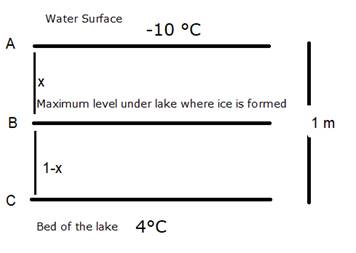Consider the situation of the previous problem. Assume that the temperature of the water at the bottom of the lake remains constant at 4°C as the ice forms on the surface (the heat required to maintain the temperature of the bottom layer may come from the bed of the lake). The depth of the lake is 1.0 m. Show that the thickness of the ice formed attains a steady state maximum value. Find this value. The thermal conductivity of water = 0.50 Wm–1 °C–1. Take other relevant data from the previous problem.
Given:
Temperature at the bottom of the lake: T1 = 4 °C
Temperature above the surface : T2 = - 10 °C
Depth of the lake: d = 1 m
Thermal conductivity of water: KW = 0.50 Wm–1 °C–1.
Thermal conductivity of ice: KI = 1.7 W m–1 °C–1.
Distance AB is : xAB = x m
Distance CB is : xCB = (1-x) m
Formula used:
Rate of amount of heat flowing or heat current is given as:![]()
Here, Δθ is the amount of heat transferred, ΔT is the temperature difference, K is the thermal conductivity of the material, A is the area of cross section of the material and x is the thickness or length of the material.
In the diagram, point B depicts the maximum level upto which ice can be formed inside the lake.
Temperature at B : T3 = 0°C
This ice attains a steady state maximum level. Steady state means that the temperature at any point remains unchanged.
This means that the temperature difference between points A,B and C would be unchanged.![]()
This means that the rate of heat transfer between A and B equals the rate of heat transfer between B and C.![]()
![]()
![]()
![]()
![]()
![]()
Hence, after attaining steady state the thickness of the ice below the lake is 0.894 m.